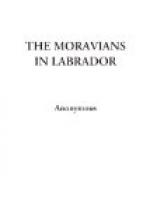When the original Hudson’s Bay Company was formed, 1688, for the purpose of trading in furs with the natives, the instructions they sent to their factors breathed the most liberal and benevolent principles. They directed them to use every means in their power to reclaim the heathen from a state of barbarism, and instil into their minds the pure lessons of Christianity; and at the same time admonished them to trade equitably, and take no advantage of their untutored simplicity. It does not appear that much attention was paid to either of these injunctions, or if there was, the efforts proved as abortive as those they made to discover the western passage. The moral wilderness still remains around their settlements on the East Maine, while those of the brethren on the opposite coast of Labrador bloom and blossom as the rose.
The first thought of attempting to establish a missionary settlement in that quarter among the Esquimaux, originated with a Moravian brother, John Christian Erhardt, a Dutch pilot. He had in early life made several voyages to Davis Straits; but in 1749, when sailing under Captain Grierson in the Irene, the vessel touched at New Hernhut in Greenland, where he saw the congregation that had been gathered from among the heathen in that land; and in conversation with the brethren they told him that they supposed the opposite coast of North America was peopled by tribes having the same customs and speaking the same language as the Greenlanders. This statement made a deep impression on his mind, and during his stay at Hernhaag, 1750, while musing on the state of that people sitting in the darkness of heathenism, and on how the light of the gospel might be communicated to them, a description of the journey undertaken by Henry Ellis, 1746-7, at the desire of the Hudson’s Bay Company, to try to discover a north-west passage, accidentally fell into his hands. The account there given of these barbarous regions convinced him that the people were sprung from the same origin with the Greenlanders, and the methods suggested by Ellis for their moral improvement enabled him to bring his own scheme to a bearing.
In a letter, dated 20th May 1750, addressed to Bishop Johannes de Watteville, he laid before him his plan for establishing a mission on that part of the coast between Newfoundland and Hudson’s Straits, which had as yet been but rarely visited by Europeans, and offered himself to undertake it. “Whoever,” says he in this letter, “has seen our cause in Greenland, and what the Saviour has done to the poor heathen there, surely his heart and his eyes must overflow with tears of joy, if he possess any feeling of interest in the happiness of others: they are indeed sparkling rubies in the golden girdle of our dear Saviour, as the text for the day speaks, Rev 1 13. And I believe the Saviour has in these northern waters many such gems that he will also gather, and set in it to his praise and glory. My heart is much impressed with the thought of carrying the




